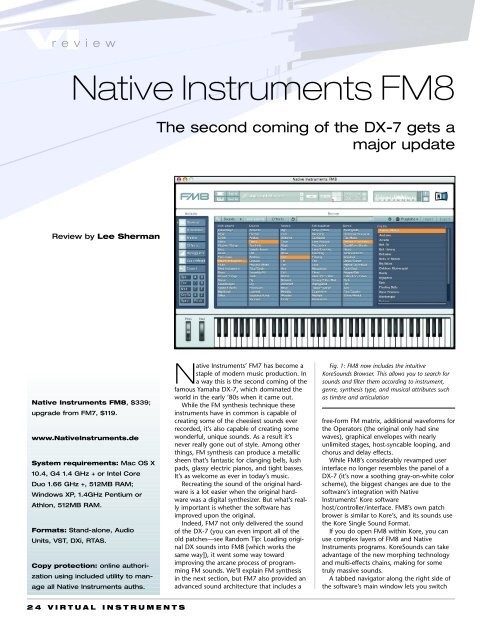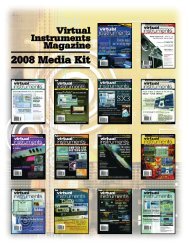Akai EWI 4000m Electric Wind Instrument Akai EWI 4000m Electric ...
Akai EWI 4000m Electric Wind Instrument Akai EWI 4000m Electric ...
Akai EWI 4000m Electric Wind Instrument Akai EWI 4000m Electric ...
You also want an ePaper? Increase the reach of your titles
YUMPU automatically turns print PDFs into web optimized ePapers that Google loves.
VI review<br />
Native <strong>Instrument</strong>s FM8<br />
Review by Lee Sherman<br />
Native <strong>Instrument</strong>s FM8, $339;<br />
upgrade from FM7, $119.<br />
www.Native<strong>Instrument</strong>s.de<br />
System requirements: Mac OS X<br />
10.4, G4 1.4 GHz + or Intel Core<br />
Duo 1.66 GHz +, 512MB RAM;<br />
<strong>Wind</strong>ows XP, 1.4GHz Pentium or<br />
Athlon, 512MB RAM.<br />
Formats: Stand-alone, Audio<br />
Units, VST, DXi, RTAS.<br />
Copy protection: online authorization<br />
using included utility to manage<br />
all Native <strong>Instrument</strong>s auths.<br />
24 VIRTUAL INSTRUMENTS<br />
The second coming of the DX-7 gets a<br />
major update<br />
Native <strong>Instrument</strong>s’ FM7 has become a<br />
staple of modern music production. In<br />
a way this is the second coming of the<br />
famous Yamaha DX-7, which dominated the<br />
world in the early ’80s when it came out.<br />
While the FM synthesis technique these<br />
instruments have in common is capable of<br />
creating some of the cheesiest sounds ever<br />
recorded, it’s also capable of creating some<br />
wonderful, unique sounds. As a result it’s<br />
never really gone out of style. Among other<br />
things, FM synthesis can produce a metallic<br />
sheen that’s fantastic for clanging bells, lush<br />
pads, glassy electric pianos, and tight basses.<br />
It’s as welcome as ever in today’s music.<br />
Recreating the sound of the original hardware<br />
is a lot easier when the original hardware<br />
was a digital synthesizer. But what’s really<br />
important is whether the software has<br />
improved upon the original.<br />
Indeed, FM7 not only delivered the sound<br />
of the DX-7 (you can even import all of the<br />
old patches—see Random Tip: Loading original<br />
DX sounds into FM8 [which works the<br />
same way]), it went some way toward<br />
improving the arcane process of programming<br />
FM sounds. We’ll explain FM synthesis<br />
in the next section, but FM7 also provided an<br />
advanced sound architecture that includes a<br />
Fig. 1: FM8 now includes the intuitive<br />
KoreSounds Browser. This allows you to search for<br />
sounds and filter them according to instrument,<br />
genre, synthesis type, and musical attributes such<br />
as timbre and articulation<br />
free-form FM matrix, additional waveforms for<br />
the Operators (the original only had sine<br />
waves), graphical envelopes with nearly<br />
unlimited stages, host-syncable looping, and<br />
chorus and delay effects.<br />
While FM8’s considerably revamped user<br />
interface no longer resembles the panel of a<br />
DX-7 (it’s now a soothing gray-on-white color<br />
scheme), the biggest changes are due to the<br />
software’s integration with Native<br />
<strong>Instrument</strong>s’ Kore software<br />
host/controller/interface. FM8’s own patch<br />
brower is similar to Kore’s, and its sounds use<br />
the Kore Single Sound Format.<br />
If you do open FM8 within Kore, you can<br />
use complex layers of FM8 and Native<br />
<strong>Instrument</strong>s programs. KoreSounds can take<br />
advantage of the new morphing technology<br />
and multi-effects chains, making for some<br />
truly massive sounds.<br />
A tabbed navigator along the right side of<br />
the software’s main window lets you switch



